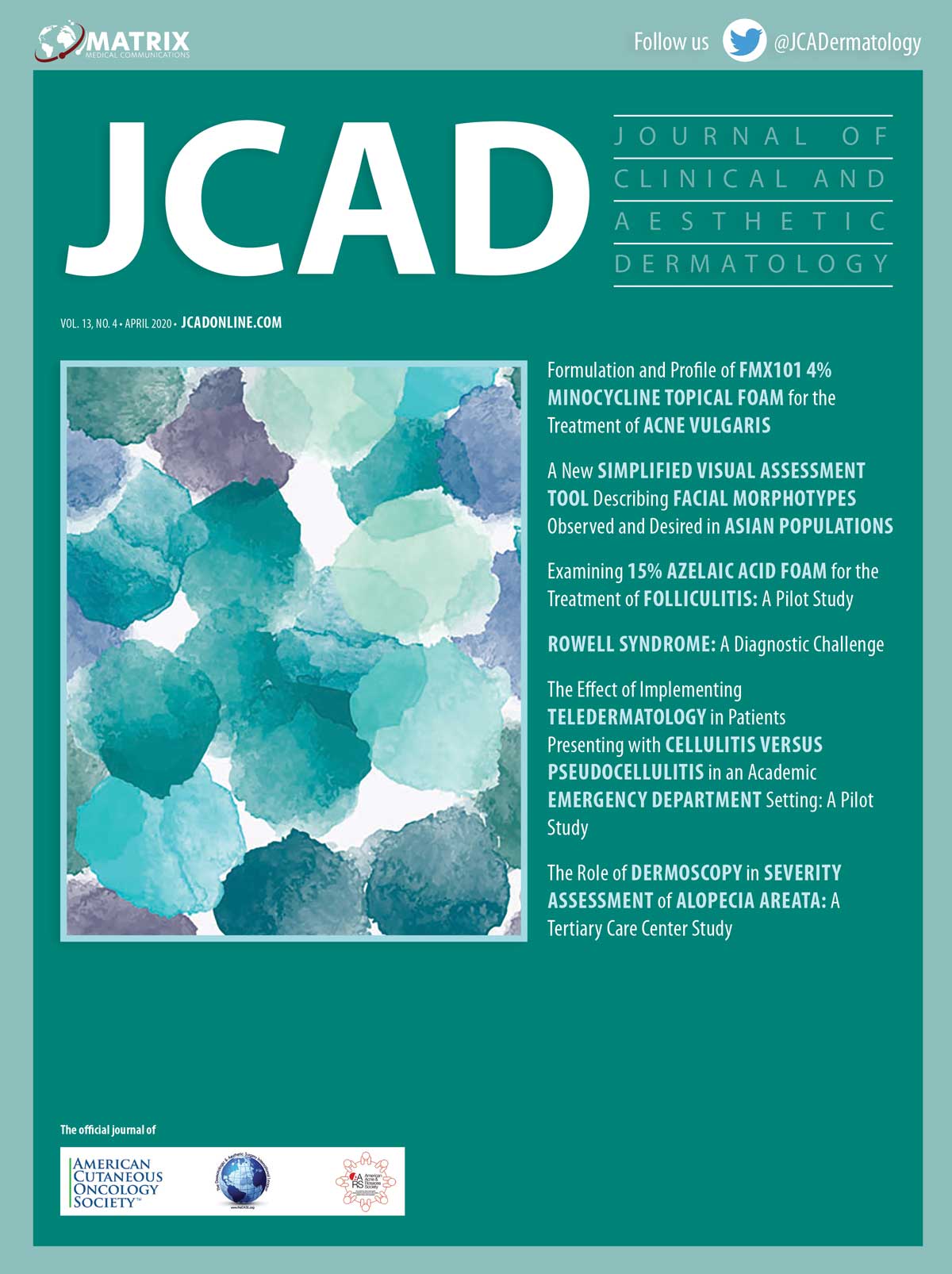Vol. 13, No. 4 • April 2020
 Dear Colleagues:
Dear Colleagues:
Welcome to the April 2020 issue of The Journal of Clinical and Aesthetic Dermatology. We begin the issue with original research from Kircik et al, titled, “Formulation and Profile of FMX101 4% Minocycline Topical Foam for the Treatment of Acne Vulgaris.” Here, the authors discuss the components of FMX101 4% minocycline, a hydrophobic, topical foam formulation of minocycline recently approved by the United States Food and Drug Administration for the treatment of non-nodular inflammatory lesions in moderate-to-severe acne vulgaris. This discussion reviews microbiologic data for FMX101 4% and presents previously unpublished data regarding sebum penetration, minocycline permeation, and disposition into skin structures. The authors also highlight data from three Phase III studies involving the safety, effectiveness, and tolerability of the topical acne treatment.
Following this, we present a consensus article from Corduff et al, titled, “A New Simplified Visual Assessment Tool Describing Facial Morphotypes Observed and Desired in Asian Populations.” The authors summarize treatment guidelines for examining Asian face morphologies that reflect accurate and current beauty standards across Asia based on results from surveys, debates, and voting from established aesthetic physicians practicing regularly on Asian patients. Based on these results, a Simplified Visual Tool of Assessment (SVAT) was developed for use in clinical practice that discerns between country variations in genetic and ideal morphotypes and considers facial index, mid-face projection, upper and lower face shape, submalar contour, nose length, dorsal height, eye shape, brow shape, lips to lower face proportions, upper-to-lower lip ratios, and shape of chin.
Next, in “Examining 15% Azelaic Acid Foam for the Treatment of Folliculitis: A Pilot Study,” Draelos evaluates the off-label use of 15% azelaic acid applied twice daily for four weeks for the treatment of folliculitis in 26 participants. The author assessed results using a five-point scale and observed changes in lesions throughout the course of the study. Reductions in lesional erythema, inflammation, papule size, extent of pustules, overall folliculitis, as well as patient-reported reductions in itching, pain, lesional pus, lesional redness, and extent of folliculitis involvement indicated the effectiveness of azelaic acid 15% as a treatment and adjunctive therapy for patients with acne.
After this, Ferillo et al report the case of a 17-year-old patient exhibiting lupus erythematosus and erythema multiforme lesions together with antinuclear antibody and anti-Ro/SSA positivity, indicating a diagnosis of Rowell syndrome (RS). The authors discuss the history of RS and the controversial nature of its debated diagnostic criteria and provide an overview of proposed diagnostic criteria currently found in the literature. The authors share their case report with the aim of contributing to the progress of RS pathophysiology knowledge and the future creation of a standard diagnostic criteria.
After, in a brief report from Wells et al, titled, “The Effect of Implementing Teledermatology in Patients Presenting with Cellulitis Versus Pseudocellulitis in an Academic Emergency Department Setting: A Pilot Study,” the authors report results from their study, in which they assigned 30 patients presenting to an emergency department with symptoms or a diagnosis of cellulitis to either a teledermatology consult (TDC) arm or standard of care (SC) to analyze the feasibility of teledermatology within an emergency setting. Patients were eventually divided by a final disposition diagnosis of either cellulitis or pseudocellulitis. Data from the pilot study exhibited, in both arms, an increased rate of persistent disease and true cellulitis and a lower rate of diagnosis adoption when compared to outpatient studies. The higher rate of persistent disease was present at 30 days in both groups, which hindered further research in sectors of the study.
Finally, Bains and Kaur provide results from their study in an original research article, titled, “The Role of Dermoscopy in Severity Assessment of Alopecia Areata: A Tertiary Care Center Study.” In their study, the authors assessed the dermoscopic features of alopecia areata (AA) and attempted to establish associations to different patterns and severity of the condition. Each participant (N=52) underwent clinical examination followed by dermoscopy. The results were tabulated and then analyzed statistically. The authors found black dots to be the most common finding in patients with AA and tulip hairs to be the least. Additionally, significant associations between yellow dots (YD) and broken hair (BH) and severity of alopecia was observed. There was a significant correlation of alopecia areata disease pattern with YD and BH (p<0.05).
We hope you enjoy this issue of JCAD. As always, we welcome your feedback and submissions.
With regards,
James Q. Del Rosso, DO, FAOCD—Editor-in-Chief, Clinical Dermatology
Wm. Philip Werschler, MD, FAAD, FAACS—Editor-in-Chief, Aesthetic Dermatology
Seemal R. Desai, MD, FAAD— Associate Editor

